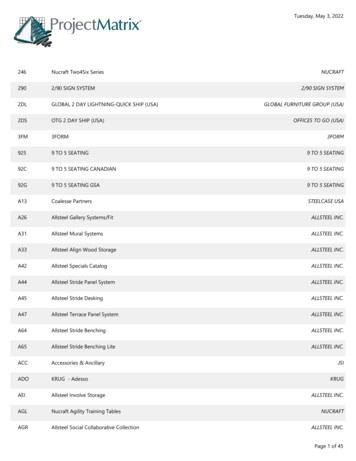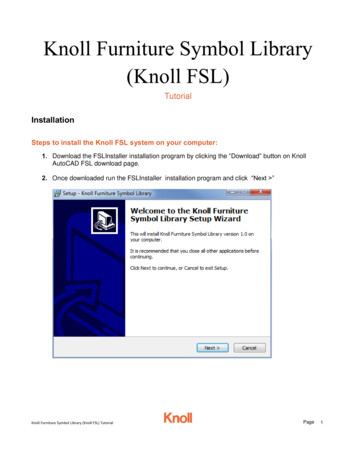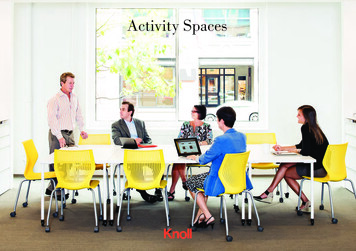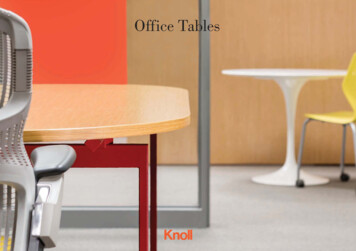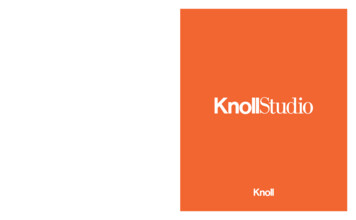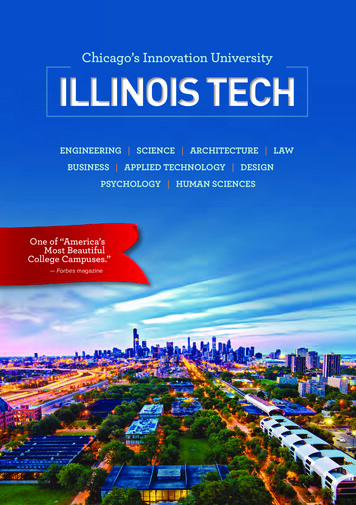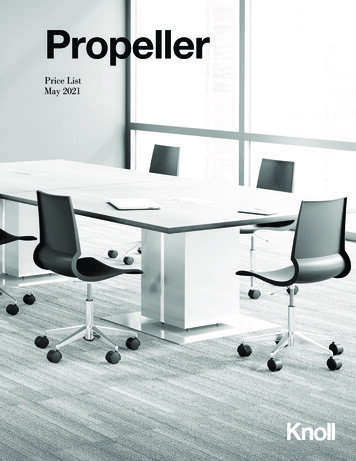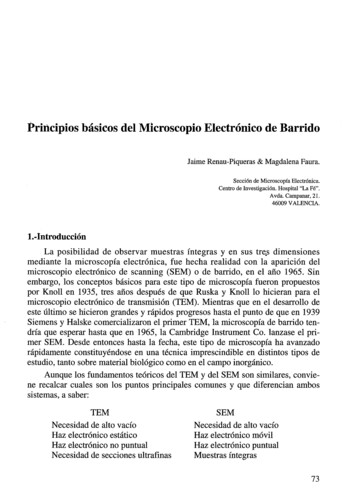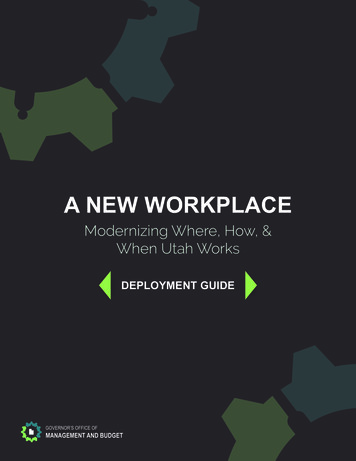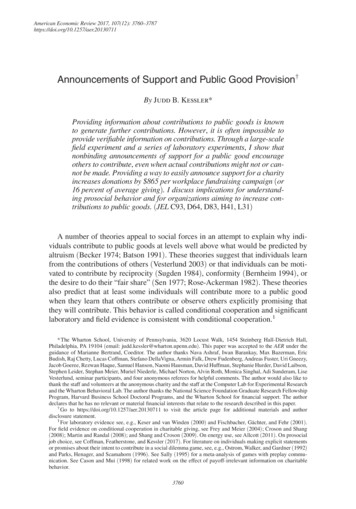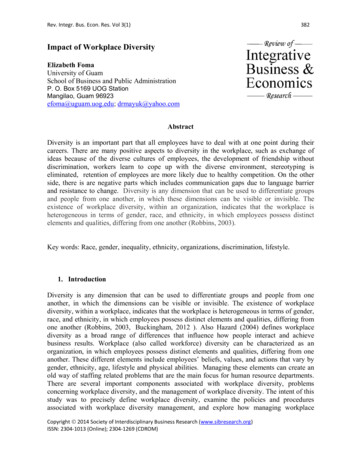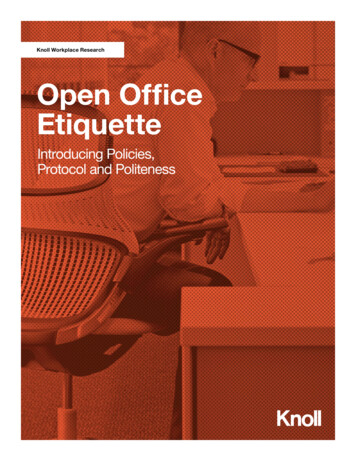
Transcription
Knoll Workplace ResearchOpen OfficeEtiquetteIntroducing Policies,Protocol and Politeness
Knoll Workplace ResearchOpen Office EtiquetteIntroducing Policies, Protocol and PolitenessCost considerations and space utilization can direct an organization’s decision to movefrom private to mostly open space. However, achieving strategic goals and supporting afirm’s mission, brand message and culture often play a more significant role. By improvingcollaboration and communication, flattening hierarchies and eliminating siloes, openenvironments can catalyze the innovation businesses seek.Removing barriers and creating a more efficient footprintbrings additional benefits. Open office environments canenhance workplace flexibility and provide the agility to meetevolving business needs. Infusing a workplace with naturaldaylight helps achieve sustainability and wellness initiatives.Transforming a workplace to a more open setting createsan opportunity to drive other organizational changes.A successful approach to the shift is pragmatic, holisticand begins well in advance of occupancy. It continuesthrough the actual transition and includes regular updatesand check-ins. Developing and introducing appropriateguidelines, expectations and etiquette to the workforcewill help streamline your firm’s adjustment to its newenvironment, minimizing downtime and lowering stresslevels. This paper provides advice on the process fordeveloping workplace protocols and presents an example ofguidelines for a hypothetical company that addresses sometypical hot button issues.while highlighting ways it will benefit them as well as theorganization. Initiate a transition from the old environment tothe new. Provide the support and tools necessary toassist employees in the change. For example, shreddingand scanning materials ease the move to digital records.Consider offering incentives or sponsoring a companywide contest for purging physical files. Involve employees in creating guidelines.Including employees in the process will further engagethem, solidify “buy-in” and sidestep a perception thatchange is “being done to them.” An appropriate level ofengagement can give employees a voice, without settingunrealistic expectations of influence.Simple Process for DevelopingWorkplace ProtocolsBefore the move Gain leadership support and sponsorship.An effective shift begins at the top. Active and visibleleaders play a critical role in times of change. It isimportant to involve them early in the process as theyprovide the authority and influence necessary for asuccessful workplace change. An employee’s directmanager also plays a significant role in providing specificinformation and reinforcing change principles. Introduce the open office concept. Using multipleforms of media and approaches, educate employeeson the changes taking place and the business reasonsfor the change. Maintain a positive, informative tone 2017 Knoll, Inc.Open Office Etiquette 1
Assemble a small group of employees who represent different areas of the business that will be moving to thenew space. Using the sample guidelines we have provided,brainstorm a list of no more than 5 to 8 issues relative toadopting an open workplace that the group feels shouldbe addressed. Within that list, include these three areasof concern: audible distractions, privacy and uninvitedinterruptions. Employee representatives can then solicit inputfrom co-workers on the specific issues, such as commonsources of noise in the office, and the collective team cancreate a short “rule” or guideline that addresses eachissue. Some issues may require more than one guideline. Consult with Human Resources to assurecompliance. Your Human Resources representativeshould be involved to ensure that any guidelines youcreate align with existing policies. Confirm that the appropriate infrastructure is inplace. Security and shared spaces reservation systemsshould be functional; individual and team workspacesshould be fully equipped and accessible. Storage andsupplies should be available. All elements of technology,including hardware, power and connectivity, must beavailable, serviceable and reliable. Be sure to provideproper training to employees and managers on how touse new spaces and technologies. 2017 Knoll, Inc.During the move Deliver guidelines. Use the release of guidelines asan opportunity to reiterate your message and celebratethe mission. Depending on the number of employeesinvolved in the change, you can incorporate theguidelines with other training meetings related to themove. If that is not practical, the guidelines can be postedon the corporate intranet and/or presented via "lunch &learn," webinar, town hall or other method appropriateto your organization’s size and culture. Guidelines shouldalso be a component of onboarding materials for new hires. Make the change a positive experience. Celebratingthe move process with events and consistent visualsand messaging acts to reinforce a positive experience.Consider providing a welcome letter from leadership anda small office-related gift to each employee on move day. Distribute all essential materials and guides. Inaddition to the sample guidelines presented, develop aprinted series of handouts such as office plans, technologyinstructions and codes, and any other needed guides thatemployees can refer to.On move day, have staff on-hand to resolve problemsand answer questions. Lead by example. Managing a successful change startsin the C-suite. Encourage all levels of the organization tofollow the suggested guidelines on a daily basis. Userswill be more inclined to accept their new workstyle uponseeing senior leaders adopting the new workplace norms.Open Office Etiquette 2
After the move Monitor and adjust. Assess the successes andshortcomings of the change process. There is nosubstitute for regular face-to face conversations andwalking around to see if policies are working and beingadhered to.Build in means for users to submit feedback on howthey feel the guidelines are working after about 90days. Based on insights learned, policies can betweaked as needed.A well-executed plan will aid in acceptance of a newenvironment. Moreover, knowing their input was consideredand future feedback welcomed will engage and encourageemployees to embrace their new space.SAMPLE GUIDELINES FOR OPEN OFFICE POLICES, PROTOCOL AND POLITENESSMEMODear Colleagues:The workplace has changed dramatically during the last decade. Advancing technology, more mobile workstyles and agreater emphasis on collaboration and teamwork have spawned new ways of working. These new workstyles drive theinnovation that propels business success. They also boost the connection and engagement that improve productivityand job satisfaction.To support the way we work today, as well as more accurately express our brand message and mission, we’ve createda new, more open workspace. By providing workplace flexibility, an open office environment gives us the agility to meetevolving business needs and accommodate today’s unpredictability and rapid change.Given that we are doing more group-based work, we have included more spaces that accommodate small meetings.We’ve balanced these with opportunities for individual concentration. While your individual workspace may be morecompact, we’ve added functionality and comfort to improve its use, while adding amenities in a variety of adjacentactivity spaces.We’ve put a greater emphasis on wellness, opening up sightlines and views so that natural daylight streamsthroughout, helping boost our physical, mental and social well-being.As with any change, our new workplace will require some conscious adjustments and embrace of what’s new. Withinput from many of you, we have established the following “Guidelines for Working at One World Place.”While we have itemized out specifics, we hope mutual respect, tolerance and consideration for your fellow co-workerwill guide your behavior.1 Noise. Success in our new environment necessitates consideration and cooperation relative to noise that distracts.Here are some pointers to maintain concentration in a collaboratively focused setting. Modulate your voice. No need to whisper – just be considerate of your neighbors when speaking near individualworkspaces. Use phone discretion. Speakerphone use, lengthy conversations and interactive webinars should only happen inenclosed spaces. If you are using a cellphone, removing one earbud can help you keep your voice at an appropriatelevel. 2017 Knoll, Inc.Open Office Etiquette 3
Be conscious of non-verbal noise. Keep cell phone and other devices on vibrate or on a low ringtone. If you havea large quantity of copies to be made or shredding to be done, consider running during times when there are fewerpeople in the surrounding area. Take advantage of huddle and gathering spaces. Move noisy conversations away from individual work settings.Lounge and café spaces are designed for impromptu, small group meetings. Reserve enclosed spaces when needed. Team activity spaces are available for larger or longer meetings.Enclave and refuge rooms are provided for extended conference calls, one-on-one conversations and focus worktime.2 Interruptions. Successful co-existence in an open office setting relies on clear communication and mutualrespect. Signify privacy preference. When appropriate, use headphones or other methods to manage distractions and toindicate that you are engaged in focus work. Read and respect privacy cues and personal boundaries. If your neighbor is wearing headphones or otherwisesignaling they are doing focused work, hold your thought for another time or send them a message.3 Privacy and Confidentiality. In an open office environment, confidential matters should be discussed in a settingthat supports the privacy of that conversation. Use discretion and judgment and be particularly conscientious whenworking on confidential projects. Utilize enclosed activity spaces. Small conference rooms are located throughout the space for sensitive orconfidential face-to-face or telephone conversations or work. Modify your surroundings. In your individual workspace, leverage your monitor arm to provide forward-lookingseated privacy. Leave no trace. Clear cache and log out completely of any shared technology device. Shred confidentialdocuments when disposing of them.4 Sharing Spaces. Enjoy the plethora of shared spaces, common and meeting areas, but please consider the nextoccupant. Honor your reservation time. Make a reservation for spaces that require it. Update or cancel your appointment ifmeetings shift or end earlier than expected. Return to order. Ensure you leave all spaces as you found them. Allow sufficient time before vacating to cleanthe room so it is ready for action by the next party.– Reset and turn off A/V equipment– Wipe off white boards– Clear tables– Return furniture to its original layout– Push chairs back into place– Return any borrowed equipment or supplies sourced elsewhere– Please do not swap out or re-locate chairs, non-mobile technology, artwork or plants– Dispose of food and drink waste appropriately in the café– Remove dirty dishes and utensils and place in the dishwasher5 Visual Cleanliness. The openness of our space provides a fresh, appealing visual for our people and our visitors.Here’s how we can all control clutter and help keep it that way. Utilize storage provided. Coats should be hung in wardrobes or shared coat closets. Personal items should bestored in desk cabinets or lockers. E-file. Minimize paper piles and files by limiting copying and printing in favor of digital archives. Keep horizons clear. Maintain open vistas and access to daylight. Do not stack items on top of overheads orhigher than panels or upmounted screens. 2017 Knoll, Inc.Open Office Etiquette 4
Keep surfaces clean. Allow windowsills and vertical surfaces to remain clear. Refrain from attaching paper orpictures to walls, glass and other vertical surfaces visible by others. Tidy as you go. When you’re leaving your workspace, especially for an extended period of time, push in yourchair, turn off task lights, organize your piles and make sure that the space is visually clean.6 Odors. In an open environment, odors are experienced by all members within a close space. Enjoy snacks and lunch in appropriate community spaces. Refrain from eating strong-smelling foods at yourdesk. Consume popcorn and other pungent snacks in the café. Keep food under wraps. Store food in sealed containers in the café area. Steer clear of scents. Avoid using strong-smelling perfumes, lotions and room fresheners in the openworkspace. Clear food from activity spaces. Dispose of all food and waste from meetings or other group events beforevacating enclosed rooms.7 Wellness. We have planned our space with centralized services that encourage movement and access to daylight.We encourage you to take advantage of all opportunities to preserve mental and physical health and well-being. Maximize movement. Take the internal stairs whenever possible instead of the elevator. Enjoy a walk at lunch.Switch to a standing desk for part of the day. Consider a walking or standing meeting. Bring your healthy self to work. Leave “sick” germs at home to keep shared spaces and close workingenvironments healthy for all. Conceal cords and clutter. Extensive power outlets are provided. Avoid tripping hazards by containing looseitems and keeping cords out of traffic patterns.8 Sustainability. Small efforts by all help us meet our mission of living green and reducing our carbon footprint. Recycle. Use designated receptacles to dispose of paper, cans and bottles. Minimize. Bring only what you will use in a day to store in refrigerators. Conserve power. Turn off lights when areas are not in use. Turn off equipment at the end of day. Dispose of trash. Keep our grounds and parking lots litter-free. Use designated receptacles. Think digital. Avoid printing, copying and accumulating paper when digital filing and sharing will suffice.Thank you for your continued cooperation and consideration in helping us achieve our goal of creating a space thatmakes you feel your best at work.Through research, Knoll explores the connection between workspace design and human behavior, health and performance, and thequality of the user experience. We share and apply what we learn to inform product development and help our customers shape their workenvironments. To learn more about this topic or other research resources Knoll can provide, visit www.knoll.com/research 2017 Knoll, Inc.Open Office Etiquette 5
brings additional benefits. Open office environments can enhance workplace flexibility and provide the agility to meet evolving business needs. Infusing a workplace with natural daylight helps achieve sustainability and wellness initiatives. Transforming a workplace to a more open setting creates an opportunity to drive other organizational .
